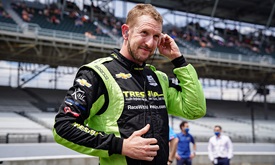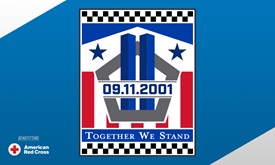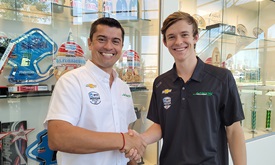Humble Beginnings Help Palou Keep Cool in Hot Title Race
SEP 02, 2021
If there’s one thing the NTT INDYCAR SERIES paddock has learned about Alex Palou this season, more than his immense talent or his drive to be exactly like teammate Scott Dixon, it’s that he’s just happy to be here.
A heartbreakingly close second-place finish in the Indianapolis 500 presented by Gainbridge? “I’m super proud of finishing second.” A mechanical failure while running fourth on the IMS road course in August? “It is what it is.” Losing the points lead after a crash at World Wide Technology Raceway? “Nothing we could have done differently, right?”
That’s because Palou didn’t think he would be here.
The Spaniard doesn’t come from a racing family. He doesn’t come from money, either. Growing up, he said he didn’t have a full fence around his house, which is common in Europe. Instead, it was half a fence.
At age 5, Palou’s entire family went in on a go-kart for his birthday after the local karting track caught his eye on the way to and from school. Every afternoon after school, Palou and his dad would go to the track.
One day, when Palou was 7, a track employee noted his speed and insisted he take part in a race at the track. They entered the race and started what Palou called a slow transition from humble beginnings to a star driver of the 2021 NTT INDYCAR SERIES season, battling for the Astor Challenge Cup.
“I think about where I came from every day,” Palou said. “I talk to my family every day. I know where I come from because I’m still that guy. I’m no different now. I just drive faster cars and it’s in a bigger championship, but I’m the same guy.
“I think now the fans know more about my heart. They are not going to see the star or celebrity, because I’m not a driver like that. I’m not super good with social media. I don’t do crazy moves on the track. I think they know more about my heart and my passion for racing, and that’s a good thing.”
When Palou started racing karts in Spain, it was a family affair with his dad as his mechanic, in part to save money. As the wins and championships racked up and travel became more frequent, his uncle became his mechanic.
After scoring six Spanish karting championships, Palou and his family began to realize there might be a career for him in racing. Then, at age 14, Palou was accepted into Centre d’alt Rendiment, a high-performance center for athletes in Barcelona. He was one of just three race car drivers per year to make it into the elite organization that provides athletes everything they need to become international stars.
For the next three years, Palou went to school and trained like an Olympic athlete. He stayed on campus during the week and went to class, trained, ate specially prepared dinners, saw sports psychologists and much more.
He used pools, tennis courts, soccer fields, sports halls and more at this 400-student campus to train into the athlete he is today, alongside fellow rising international athletes such as men’s tennis player Pablo Carreño Busta, who currently ranks 12th in the world on the ATP Tour.
Just one year into his stay, Palou landed a role as a factory karting driver that offered the best team, the best equipment and the best chance to win races. He finished second in the European Championship to rising Formula One star George Russell and fourth in the world karting championship all in one year.
Palou was finding much success, but he thought this was his limit. The next logical step – single-seaters – was too expensive for he and his family. Palou estimates that one single-seater test would cost eight months’ worth of his family income.
“My family and I, we never thought to try to be a race car driver,” Palou said. “Go-karting is super expensive, and we could not afford it. So why should we think about a single-seater? It was not even on our radar. You cannot even think about doing a test.”
But Palou won the Spanish karting championship, and with that came $30,000 to be used toward a single-seater test.
The test was a rousing success, both in terms of speed and fun. Palou showed impressive pace, and it led to rides in Euro Formula Open in 2014 and GP3 in 2015 and 2016. Palou struggled to find consistent success in the latter, and after two years his GP3 experiment was over.
Refusing to give up after making it this far in racing, Palou set his sights on Japan with a Dallara F3 test. He finished third in the Japanese F3 championship in 2017 and caught the eye of Honda in Super Formula. At a test in 2018, Palou was the fastest Honda-powered driver with a promise for a ride in 2019.
But Palou had an ulterior motive in joining forces with Honda in Super Formula, and he made it very clear: This was his path to the NTT INDYCAR SERIES, where Palou always wanted to race. He was intrigued by ovals, the competitiveness throughout the field and moving to the United States.
“I made sure in the interviews with everybody I was speaking to that I was super happy, the happiest man on Earth, but I would be even happier if I was in INDYCAR,” Palou said. “If you ask Team Goh or Honda in Japan, they’re going to tell you that from the first time … I was like, ‘Man, I want to go to INDYCAR.’”
Team Goh and Honda organized a test with Dale Coyne Racing in 2019 at Mid-Ohio Sports Car Course. He showed enough promise at the test that after he narrowly lost out on the Super Formula championship, Palou came to the NTT INDYCAR SERIES driving for Dale Coyne Racing with Team Goh.
While Palou was finally living out his dream of racing in North America’s premier open-wheel series, there was still something missing.
One day while he was still in Japan, Palou fell into a rabbit hole of INDYCAR YouTube videos. He stumbled upon an interview with Chip Ganassi, and Palou immediately knew that was the man for whom he wanted to drive.
“I saw that I was a guy with a mentality like him,” Palou said. “There are not many people that only have racing in mind. I think there are people that enjoy racing and have other businesses, which is cool. That’s probably really intelligent. But there’s a small amount of people that only have racing in mind, and I think I’m like that. I just want to win. That’s what he wants.”
Palou considers himself to be more reserved, rarely going out of his way to mingle with strangers and introduce himself to people. That’s why he was extremely nervous when he introduced himself to Ganassi during the Indianapolis 500 in August 2020.
One day in the motorcoach lot, he mustered up the courage to stop the 13-time championship winning team owner and say, “One day I want to drive for you.”
“Keep digging and keep working on it,” was Ganassi’s reply to Palou, who had just put together a surprise performance in the Firestone Fast Nine for the “500,” where he qualified seventh.
The next time the NTT INDYCAR SERIES returned to the Indianapolis Motor Speedway for the Harvest Grand Prix in October, Palou’s team had set up a meeting with Ganassi about taking over the No. 10 NTT DATA Chip Ganassi Racing Honda.
“I was so nervous. Like, ‘What’s going on?’” Palou said. “I was so confused. You don’t expect that. We had a good year last year, but it was not a fantastic year where everybody’s trying to get you, which is normal. But if the championship-winning team is interested in you, that’s a big deal.”
Now racing for arguably the strongest team this season in the INDYCAR paddock, Palou has won twice this season and is second in the race for the Astor Challenge Cup with three races to go. It seems all of Palou’s wildest dreams are coming true.
If history has anything to say about it, Palou is going to consider any of the possible championship outcomes a success, and he’ll likely say he’s the happiest man on Earth.
But with so many career goals met or nearly achieved at age 24, Palou has his sights set on a 2022 goal: get his entire family to the racetrack, just like the good old days in Barcelona, Spain. Due to the COVID-19 pandemic, very few members of Palou’s family have been able to see him race in person.
“Already from the day of my birthday that my family got the money together, they were all at that track the first day, and they would try to go to a lot of races, and they would support me,” he said. “When you race in Japan, nobody was able to come and visit because it was so expensive, but hopefully next year COVID is OK, and I’ll bring my family here.”




















